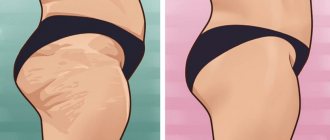Wide ankles for women. 9 ways to get rid of fat ankles and calves
Wide ankles can be inherited from relatives, but most often they appear as a result of many other reasons. If you're unhappy with your calves and ankles, you can try a variety of ways to improve the situation, from diet and exercise to correcting medical problems.
Lose weight
If you notice that your calves are thickening, then you should bring your weight back to normal. Most often, this part of the leg becomes wide due to the deposition of fat cells. The best choice would be a healthy and balanced diet, but sharp dietary restrictions can only harm your health.
Prevent fluid retention
If your weight has remained stable and your calves and ankles have become thicker, the problem is likely fluid retention. Reduce your intake of salty foods and drink enough water. Reducing the amount of sodium in your diet will actually improve the situation. Exercise will also be beneficial, as you will also remove sodium from the body through sweat.
Exercises
There are no exercises that will help you lose weight in this area, so choose workouts that strengthen the muscles in your feet. Cardio will help you stay in shape, but if you're concerned about your calves and ankles, it's best to supplement it with more specific exercises. Jumping rope, walking or climbing stairs, as well as ankle raises and squat jumps can help improve the appearance of your legs.
Check your medications
Some medications can also cause or worsen the problem. Most often, swelling in the ankle area is caused by blood pressure medications and antidepressants. If you notice that your lower legs begin to swell after starting treatment, consult your doctor about alternatives. Antidepressants can also cause weight gain, which can also negatively affect the appearance of your legs.
Most often, swelling in the ankle area is caused by blood pressure medications and antidepressants.
Wear massage shoes
If you want to improve the condition of your ankles, special shoes can help. Nowadays, many companies promise that their products will keep your legs toned while walking. Reviews about such shoes are still contradictory, but it’s worth a try. The main thing is to choose proven brands.
Change your contraceptive method
Hormones are directly linked to weight gain and swelling of the ankles. If you notice problems with your legs after a few months, ask your doctor to try a different medication to minimize side effects.
Rule out medical problems
Swollen ankles can be caused by a number of serious medical problems, from thrombosis to internal organ diseases. Warning signs are redness on the ankles, different temperatures in this area and in other parts of the body. Apply pressure to the swollen area. If the skin does not return to its original position quickly enough, you have serious fluid retention, which is worth seeing a doctor about.
If you're pregnant, get a massage
During pregnancy, it is almost impossible to get rid of swollen ankles. During this period, hormonal changes and poor circulation cause problems. It's best to reduce your sodium intake as it only makes things worse. It is important to maintain physical activity throughout your pregnancy; ankle training will help improve circulation and reduce swelling.
Embrace Genetics or Try Liposuction
The most radical way to get slender ankles is liposuction, but this is not an entirely safe procedure. However, if you have tried everything and have not achieved any results, then the problem is most likely genetic. In this case, you may consider surgery.
How to hide full legs using the example of Lupita Nyong'o
Lupita often appears on lists of the best dressed stars. Most red carpet appearances are perfect, with the exception of some misunderstandings. She is brave and sometimes this does not work in her favor.
And so, let's look at Nyong'o's figure in detail.
She has a proportionate figure, small breasts, a pronounced waist, sharp shoulders and there is a small but - Lupita’s legs are plump. This is almost the standard figure of a dark-skinned woman, but Lupita not only has large hips, but also plump calves. If you choose the outfit incorrectly, the difference in the volume of the upper and lower parts of the figure will be very noticeable.
And as soon as an extra couple of kilos appear, they are immediately deposited on the legs.
This is a clear example of how not to dress. Flat shoes and tight trousers not only increase the volume of your legs, but also shorten them.
In fact, with such a figure, almost any length of skirt is suitable, but only in combination with the right shoes.
The first rule: the skirt is shorter - the heel is higher.
And don't forget about color. Dark lengthens the legs, light shortens them
.
Rule for shoes: often choose heels, wedges, choose shoes that are light in shape, and avoid straps.
The shoes here are a bit heavy. As a result, plump legs attract too much attention.
Straps
not only divide the legs and shorten them, but also emphasize fullness. In this example, the stylist did the right thing. They did not abandon the strap and lightened the lower part of the figure by increasing the upper part. The dress is light and made of voluminous jersey.
Here they also balanced the figure with a jacket with sharp shoulders and large beads on the neck.
Now let's talk about proportions.
If we don’t emphasize the waist, then we increase the hips. If we enlarge or draw attention to the shoulders and chest, then choose a modest bottom.
Let's get back to the trousers.
Everything is taken into account here. Lightweight high heels.
Pay attention to the deep neckline, and the trousers are slightly flared from the hip and elongated.
Plus they emphasized the waist with a belt.
And this jumpsuit adorns Lupita’s figure, although it hides her breasts.
If we talk about an image for every day, then this example is quite suitable:
I like this image. Yellow suits Nyong'o very well. Short shorts are just right for a young girl. The top is voluminous, shortened, which lengthens the lower part of the figure. Plus dark heels.
Another such positive example. Please note that the shorts are not tight, but have a classic cut.
And now some examples of skirts
that are suitable for this type of figure.
Long, light, fit, no frills, large flowers, etc.
Straight below the knee and flared to the knee. But the top should be modest. No puff sleeves, long necklines, huge prints.
A fun and bold look for every day. I tried to distract attention with a large red bag. But these straps on sandals...
Here, the print, the length of the trousers, and the shoes play in favor of the figure.
Layering, wide, voluminous skirts combined with a heavy top add extra pounds.
Below is a better look paired with a voluminous skirt.
Off the red carpet, Lupita experiments. She loves layers. She's beautiful. But one small detail was left out. Shoes should not cut the ankle. And one more example:
Sometimes a strap has a right to exist if these are light sandals.
Now for a better choice of shoes.
Remembering shorts, the same rule applies to skirts. Short tight minis are prohibited. It is better to choose a mini one in the shape of a trapezoid.
Selection of outerwear
according to the same rules: do not forget to emphasize the waist, volume either above or below.
And some more beauty:
Photos used: fashionbombdaily.com, iledebeaute.ru, entertainthis.usatoday, photos.essence.com, pixel.brit.ko, megasabi.com
And links to previous episodes:
How to add volume to flat buttocks using the example of Angelina Jolie
How to hide figure flaws using the example of Olivia Wilde
How to make a boyish figure more feminine using the example of Eva Longoria
How to balance a figure with broad shoulders using the example of Nastya Volochkova
Wide ankles in women, what shoes to wear. High heel
When buying shoes, women with imperfect ankles must follow a few simple rules, the first of which is: buy shoes exclusively with heels. This statement especially applies to shoes - both weekend and everyday. However, there are some limitations here too, so you shouldn’t be too hasty in sweeping options with high heels or platforms off the counter. Only shoes with the correct length and shape of the heel can make your legs visually slimmer and longer.
For women with wide ankles, the following types of heels are preferable:
- Short. Ladies with short stature should pay attention to models with heels from 1.5 to 2 cm. This option is not only practical and comfortable as everyday shoes, but also goes well with any type of clothing: trousers, skirts, dresses, and so on. Tall girls with long legs can safely purchase moccasins with a heel of about 0.5 cm.
- High. Most women are mistaken that only the highest heels can hide imperfections and make their legs slimmer, visually lengthening them. This is not entirely true. The optimal heel size should not exceed 7 cm. More daring options will cause difficulties when walking, forcing you to slouch and bend your legs, and this will only aggravate the situation. In addition, high-heeled shoes are not the best option for going to work or shopping. Another thing is to use similar models for special occasions.
- Wide. Such a heel is not only the most stable and comfortable, but also makes the ankles visually slimmer. It is ideal for girls with extra centimeters on their calves, ankles and hips. Stylists advise choosing summer shoes with wide heels in dark shades (brown, black). White and cream models can visually expand already full legs.
Heel pain
Arthritis
Diabetes
8374 06 April
IMPORTANT!
The information in this section cannot be used for self-diagnosis and self-treatment.
In case of pain or other exacerbation of the disease, diagnostic tests should be prescribed only by the attending physician. To make a diagnosis and properly prescribe treatment, you should contact your doctor. Heel pain: causes of occurrence, what diseases it occurs with, diagnosis and treatment methods.
Definition
Pain in the heel area not only causes discomfort, but also deprives a person of the ability to stand for a long time and move normally. Pain usually occurs due to inflammatory changes in the tissues surrounding the heel bone and is often long-lasting and recurrent. The heel bone is the largest of all the bones in the foot and bears the most stress when walking.
Types of heel pain
Depending on the disease that is accompanied by heel pain, the nature of the pain syndrome will vary. Acute pain may occur when walking and standing. The pain may appear in the morning when a person gets up after sleep, then it decreases or goes away completely. In other cases, heel pain is aching in nature and is not associated with the load on the leg. In a number of diseases, pain bothers you not only when walking, but also at night, at rest. Sometimes, along with the pain, numbness, tingling and goose bumps are felt, the skin may turn red, and swelling appears.
The pain may intensify when the foot is extended, and in some cases causes limited mobility in the ankle joint.
Possible causes of heel pain
Causes of heel pain can be divided into physiological and pathological. The first includes overstrain of the foot due to wearing uncomfortable shoes or shoes with flat soles and without arch support, due to prolonged standing, due to increased stress on the foot during pregnancy or rapid weight gain.
Pathological causes include various diseases and injuries.
Achilles tendonitis and plantar fasciitis (heel spur)
. During physical activity and overstretching of the tendons attached to the heel bone, inflammation occurs, which is manifested by pain in the heel and in the tendon area during physical activity, local swelling along the back of the heel, and a feeling of weakness in the ankle joint. Flexion and extension of the foot is painful. Achilles tendonitis (achillodynia) is often a consequence of spondyloarthritis (disease of the intervertebral discs), joint hypermobility (hereditary disease or predisposition), flat feet, shortening of one of the lower limbs due to pelvic distortion due to intervertebral herniation.
Plantar fasciitis, or heel spur, is also characterized by inflammation of the plantar ligament. The consequence of this process is the formation of heel spurs, that is, marginal bone growths (osteophytes). Patients report pain when walking and standing along the entire plantar surface of the foot.
Most often, pain makes itself felt during the first steps after a night's sleep or prolonged sitting.
Tarsal tunnel syndrome
is characterized by damage to the fibers of the tibial nerve due to its compression between the ankle ligaments due to injuries, bone growths and soft tissue tumors. The syndrome is accompanied by burning pain and tingling in the heel area, and sometimes the entire sole. The pain intensifies when the foot is extended. There may be a change in skin sensitivity in the sole area. Tarsal tunnel syndrome often affects foot function and gait.
Traumatic injuries of the heel bone (bruise, crack, fracture)
. Heel bone injury most often occurs when falling or jumping from a height in a vertical position. A strong blow leads to a bruise or disruption of the integrity of the bone (often combined with fractures of other bones of the lower extremities) and causes sharp pain, inability to support the heel, and swelling that covers the foot and lower leg.
Damage to the heel bone is rarely accompanied by an external violation of the integrity of the soft tissues; hematomas are more often observed on the lateral surfaces of the foot.
Achilles bursitis
is a disease characterized by inflammation of the synovial bursa, which is located between the heel tendon and the heel bone, and is manifested by pain at the bottom and behind the heel, at the site of attachment of the Achilles tendon to the heel tubercle, redness and swelling in the area of the heel tubercle, as well as partial limitation of foot mobility. Achilles bursitis can be caused by traumatic injuries due to wearing tight shoes, excessive physical stress on the ankle joint, or Haglund's deformity. Less commonly, the disease is caused by metabolic and hormonal disorders, allergic reactions, autoimmune diseases, and infections.
Reactive arthritis
- arthritis of the joints, of which the calcaneus is a part (the articulation of the calcaneus with the tarsal bones - the talus and navicular).
The disease develops as a consequence of previous infectious diseases (most often urogenital).
Pain syndrome appears two weeks to a month after the infection. Severe pain is felt not only during exercise, but also at rest. Both heels may be affected and there may be swelling and redness.
Infectious diseases
(tuberculosis, gonococcal infection, calcaneal osteomyelitis) is a fairly rare cause of heel pain. Mycobacterium tuberculosis and gonococci can develop in spongy bones and epiphyses of tubular bones, which leads to their local destruction. The process is accompanied by pain, swelling in the ankle joint and redness. Mobility of the foot is impaired.
Haglund's deformity
- ossification of the calcaneus, in which osteochondral growth occurs in the area of the heel tubercle, accompanied by the appearance of a growth (osteophyte) in the area of attachment of the Achilles tendon. This pathology can be caused by a high arch or planovalgus deformity of the foot (a combination of flat feet and valgus deformity of the foot - deviation of the big toe towards the other toes), decreased elasticity of the tendons.
Valgus deformity of both feet
Constant friction of the Achilles tendon leads to the development of an inflammatory process and changes in the cartilage, sometimes with the formation of sharp spines. Patients may notice a hard bump on the back of the heel. The function of the foot, as a rule, is not impaired, but inflammation of the joint capsule and tendon sheath leads to pain when walking, and sometimes at rest.
The disease is more common in young women due to wearing uncomfortable high-heeled shoes.
Calcaneal epiphysitis
- this disease develops in children aged 8–15 years due to disruption of the processes of ossification (ossification) of the calcaneus. Normally, the calcaneus is formed as a result of the activity of two ossification centers. One of them functions from the birth of a child, the other - from about 8 years old. Between the centers of ossification there is cartilage tissue, which over time is transformed into bone. If the cartilage tissue between these two areas is overloaded, cartilage degradation or partial rupture is possible, which is accompanied by inflammation and pain on the back and side of the heel, which increases with load. There is a limitation in the range of motion, and when the cartilage ruptures, there is swelling and redness.
Osteochondropathy of the apophysis of the calcaneal tuberosity, or Haglund-Schinz disease
- the disease is characterized by aseptic (non-infectious) necrosis of the calcaneal tubercle, which occurs due to trauma, wearing uncomfortable shoes, due to hereditary predisposition and hormonal imbalance. The tendons attached to the tubercle, when overstrained, constantly injure the bone, which causes pain and swelling, which intensify after exercise and when the foot is extended. A swelling can be seen above the heel tubercle. It has been noted that Haglund-Schinz disease is more common in girls aged 12–16 years.
To reduce the severity of pain, patients lean on their toes when walking.
Heel pain can be caused by dermatological and vascular pathologies, which are diagnosed in patients with diabetes (trophic ulcers in diabetic foot syndrome), varicose veins, and thrombophlebitis. Patients experience slight tugging, nagging pain, and fatigue. Swelling of the feet and intermittent claudication are observed.
Which doctors should I consult for heel pain?
If you have heel pain, especially in case of injury, it is recommended to consult an orthopedic traumatologist. In some cases, consultation with an infectious disease specialist and other specialists is required to determine the diseases that caused the pain.
Diagnosis and examinations for heel pain
When pain in the heel occurs, a thorough history and instrumental examination are necessary. First of all, a clinical blood test is prescribed, as well as tests for infectious diseases - chlamydial and gonococcal infections, tuberculosis.
Women have wide ankles by nature.
Doctors from the Laboratory of Human Physiology from the University of Columbia (USA), in collaboration with paleontologists, found that the positive reaction of men to thin female calves, smoothly rising from graceful ankles, is an unconditioned reflex.
Having compared several dozen skeletons of prehistoric women (skulls and ankles), scientists concluded that women with thin calves had larger skulls. The aesthetic image of an attractive female in the subconscious of men consisted not only of a narrow waist and high breasts. Thin ankles underwent evolutionary selection in those women who could not walk for a long time, but preferred to “do housework” - keep the fire, tanned hides, and cook food.
Such women developed a better intellect, which means it was easier to find a common sexual language with them - what we now call love. Modern men have inherited the reaction to slender female calves as an unconditioned reflex.
Graceful ankles and small feet (especially for tall women) in France have been a sign of noble birth in all centuries. Yes, yes, exactly the legs. Not even hands: aristocratic women in the 18th century could have large hands if they played ball a lot as children (a common sport for women). But the legs - they always gave away their origin. Therefore, aristocrats tried to emphasize the thinness of their ankles and the smooth line of their calves with flirty shoes.
To keep your ankles toned
Do a simple exercise every day. Stand in front of the stairs, legs straight, arms at your sides, back straight. Lift your chin, look forward. During the exercise, the buttocks should be tense and the stomach should be pulled in.
Place your left foot on the step and lean your upper body forward until you form a straight line with your right leg. The right leg is extended, the heel is pressed to the floor. Distribute your body weight evenly on both legs (repeat 20 times on each leg, doing 3 sets).
Wide ankles in women, what to do. What to do if you have thick ankles
It often happens that despite having slender and beautiful legs, girls have fairly wide ankles. And when you gain excess weight, this problem becomes completely total. Your legs look like two pillars and, especially in summer, you have to give up clothes that highlight your ankles. For example, sandals and shorts are excluded, and high heels do not emphasize the beauty of your legs. On the contrary, it draws attention to shortcomings. What to do about this problem?
Fat deposits located between the shins and ankles, when present in excess, can make a person truly unhappy. But there is no need to despair, this can be solved. The first thing to start with is this. It is known that local fat burning is not possible, so if you want to get rid of excess fat in some specific parts of your body, then be prepared to lose fat everywhere. In addition, fat is not distributed and processed in our body evenly. So in this matter you need to be patient. Even if you see progress throughout your whole body, but your ankles are practically unchanged, don’t be discouraged, over time, progress will reach this area. In addition to standard exercises, you can add more calf exercises. For example, calf raises. This exercise can be performed on one leg or two, dynamically (walking on toes) or statically (lifting half toes with weight). This exercise will help, in parallel with the loss of fat, to slightly change the proportions. Your calves will become more prominent and even your naturally wide ankles will appear more graceful.
You don't need any additional equipment to perform calf raises. When performing single-leg calf raises, you do not need additional weights - this exercise is performed with your own body weight. All you need is a chair back or some kind of support so you can hold on to it and maintain your balance. When performing the exercise, you lift the foot of the supporting leg onto the toe, the second leg is bent at the knee joint. It is important to contract the calf muscle as much as possible at the top point and keep a short pause at the point of maximum tension (2-3 seconds is enough). You can regulate the load yourself: the higher you rise, the greater the tension in the muscles.
Also, don’t forget that when it comes to weight loss, your best friends are proper nutrition and. Not only will they help slim down your ankles and calves, but they will also have a positive effect on your entire body. After your workout, don't forget to stretch - this is very important.
In addition to excess weight, large ankle volume can be associated with swelling and the easiest way to find out if you have swelling is to press your finger on your ankle. If there is a slight dent in your skin, then most likely the problem is fluid retention. In order to get rid of swelling (applicable to the whole body, not just the ankles), you need to reduce the level of salt you consume, control that the amount of carbohydrates for dinner is minimal and comes only from non-starchy vegetables (there is starch, carrots, corn, beets ), eliminate alcohol and maintain proper drinking regimen.
Use these methods, be patient, and your legs will definitely delight you with their appearance.
Cause of thick ankles
Thick ankles are the result of excess weight or heredity.
The main reason is excess weight. Women of different ages face this problem; the distribution of fat is individual, it is determined at the genetic level. Often the area of the hips, abdomen and legs increases, including the area of the lower leg and ankle.
Eating small, frequent meals will help you lose weight.
If after 1-2 weeks the results are not noticeable, do not despair, ankle reduction is a very long process and requires patience.
Other factors:
- Diseases of internal organs, mainly disruption of the cardiovascular system.
- Taking medications - a group of antidepressants, drugs for regulating blood pressure and contraceptives often cause swelling, swelling of the legs and cause fat gain. Therefore, before using them, you should consult your doctor.
- Pregnancy. During this period, the volume of the entire body increases, metabolism is disrupted, and hormone levels become unstable. This leads to constant swelling in the calves and ankles. Foot massage and light physical activity will help alleviate the condition.
- The hereditary factor is what is responsible for the shape and size of the ankles. If your immediate family has a stocky build and massive legs, it is impossible to achieve thin ankles without surgery. Their silhouette can only be visually adjusted by choosing the right clothes and shoes.
Even if thick ankles are inherited, there is still a chance to transform in appearance, the main thing is to have a strong desire and strive for it.











